Aveiro Canyon Head (Portugal) Submarine Slope Instability Assessment
Abstract
1. Introduction
2. Setting
3. Methods
3.1. Information Value (IV)
3.2. Logistic Regression (LR)
3.3. Model Validation
4. Data Acquisition and Processing
4.1. Inventory of Mass Movements
4.2. Predisposing Factors
5. Results, Validation and Discussion
- (1)
- depths larger than 900 m;
- (2)
- mean slope angle between 5° and 20°, and above 40°;
- (3)
- slope face exposed to the east quadrant (E–SE);
- (4)
- bottom surface with concave profile;
- (5)
- sedimentary deposits composed by medium to fine silt.
6. Final Considerations
Author Contributions
Funding
Acknowledgments
Conflicts of Interest
References
- Hampton, M.A.; Lee, H.J.; Locat, J. Submarine landslides. Rev. Geophys. 1996, 34, 33–59. [Google Scholar] [CrossRef]
- Borrell, N.; Somoza, L.; León, R.; Medialdea, T.; Gonzalez, F.J.; Gimenez-Moreno, C.J. GIS Catalogue of Submarine Landslides in the Spanish Continental Shelf: Potential and Difficulties for Susceptibility Assessment. In Submarine Mass Movements and Their Consequences: 7th International Symposium; Lamarche, G., Mountjoy, J., Bull, S., Hubble, T., Krastel, S., Lane, E., Micallef, A., Moscardelli, L., Mueller, C., Pecher, I., Eds.; Springer International Publishing: Cham, Swizerland, 2016; pp. 499–508. [Google Scholar] [CrossRef]
- Masson, D.G.; Harbitz, C.B.; Wynn, R.B.; Pedersen, G.; Løvholt, F. Submarine landslides: Processes, triggers and hazard prediction. Philos. Trans. A Math. Phys. Eng. 2006, 364, 2009–2039. [Google Scholar] [CrossRef] [PubMed]
- Vanneste, M.; Forsberg, C.F.; Glimsdal, S.; Harbitz, C.B.; Issler, D.; Kvalstad, T.J.; Løvholt, F.; Nadim, F. Submarine landslides and their consequences: What do we know, what can we do? In Landslide Science and Practice, 1st ed.; Margottini, C., Canuti, P., Sassa, K., Eds.; Springer: Berlin, Germany, 2013; pp. 5–17. [Google Scholar]
- Nittrouer, C.A.; Wright, L.D. Transport of particles across continental shelves. Rev. Geophys. 1994, 32, 85–113. [Google Scholar] [CrossRef]
- Schmidt, S.; de Stigter, H.C.; van Weering, T.C.E. Enhanced short-term sediment deposition within the Nazaré Canyon, North–East Atlantic. Mar. Geol. 2001, 173, 55–67. [Google Scholar] [CrossRef]
- Harris, P. Seafloor Geomorphology—Coast, shelf, and abyss. In Seafloor Geomorphology as Benthic Habitat: GeoHab Atlas of Seafloor Geomorphic Features and Benthic Habitats; Harris, P., Baker, E.K., Eds.; Elsevier: Amsterdam, The Netherland, 2012; pp. 108–155. ISBN 978-0-12-385140-6. [Google Scholar] [CrossRef]
- Guerreiro, C.; Stigter, H.; Cachão, M.; Oliveira, A.; Rodrigues, A. Coccoliths from recent sediments of the central portuguese margin: Taphonomical and ecological inferences. Mar. Micro. 2015, 114, 55–68. [Google Scholar] [CrossRef]
- McAdoo, B.G.; Pratson, L.; Orange, D. Submarine landslide geomorphology, US continental slope. Mar. Geo. 2000, 169, 103–136. [Google Scholar] [CrossRef]
- Moore, D.G. Submarine Slides. Rockslides and Avalanches, vol. 1: Natural Phenomena; Voigt, B., Ed.; Elsevier: Amsterdam, The Netherland, 1978; pp. 563–604. ISBN 0-444-41507-6. [Google Scholar]
- Evans, N.C. Stability of Submarine Slopes, Geo Report No 47; Geotechnical Engineering Office, Hong Kong Government: Hong Kong, China, 1995; 51p. [Google Scholar]
- Poulos, H.G. Marine Geotechnics; Unwin Hyman: London, UK, 1988; 473p, ISBN 004620024X. [Google Scholar]
- Henkel, D.J. The role of waves in causing submarine landslides. Géotechnique 1978, 20, 75–80. [Google Scholar] [CrossRef]
- Varnes, D.J. Slope Movement Types and Processes. In Landslides, Analysis and Control. Special Report 176; Schuster, R., Krizek, R., Eds.; National Academy of Science: Washington, DC, USA, 1978; pp. 11–33. [Google Scholar]
- Mulder, T.; Cochonat, P. Classification of offshore mass movements. J. Sed. Res. 1996, 66, 43–57. [Google Scholar] [CrossRef]
- Ilstad, T.; Elverhøi, A.; Issler, D.; Marr, J.G. Subaqueous debris flow behaviour and its dependence on the sand/clay ratio: A laboratory study using particle tracking. Mar. Geol. 2004, 213, 415–418. [Google Scholar] [CrossRef]
- Bryn, P.; Berg, K.; Forsberg, C.F.; Solheim, A.; Kvalstad, T.J. Explaining the Storegga slide. Mar. Pet. Geol. 2005, 22, 11–19. [Google Scholar] [CrossRef]
- Reichenbach, P.; Rossi, M.; Malamud, B.; Mihir, M.; Guzzetti, F. A review of statistically-based landslide susceptibility models. Earth Sci. Rev. 2018, 180, 60–91. [Google Scholar] [CrossRef]
- Marques, F.M.S.F.; Matilde, R.; Redweik, P. Sea cliff instability susceptibility at regional scale: A statistically based assessment in the southern Algarve, Portugal. Nat. Hazards Earth Syst. Sci. 2013, 13, 3185–3203. [Google Scholar] [CrossRef]
- Mougenot, D. Geologia da Margem Portuguesa, Doc. Técnicos nº 32; Instituto Hidrográfico: Lisboa, Portugal, 1989; 259p. [Google Scholar]
- Rodrigues, A. Tectono-Estratigrafia da Plataforma Continental Setentrional Portuguesa. Ph.D. Thesis, Faculty of Sciences, University of Lisbon, Lisbon, Portugal, 2004; 244p. [Google Scholar]
- Lallemand, S.; Sibuet, J.C. Tectonic implications of canyon directions over the north-east Atlantic continental margins. Tectonics 1986, 5, 1125–1143. [Google Scholar] [CrossRef]
- Yin, K.L.; Yan, T.Z. Statistical prediction models for slope instability of metamorphosed rocks. In Landslides, Proceedings of the Fifth International Symposium on Landslides, Lausanne, Switzerland, 10–15 July 1988; Bonnard, C., Ed.; Balkema: Rotterdam, The Netherland, 1988; pp. 1269–1272. [Google Scholar]
- Cox, D.R. The regression analysis of binary sequences (with Discussion). J. Royal Stat. Soc. 1958, 20, 215–242. [Google Scholar] [CrossRef]
- Hosmer, D.; Lemeshow, S. Applied Logistic Regression, 2nd ed.; Wiley: New York, NY, USA, 2000; 383p. [Google Scholar] [CrossRef]
- Zêzere, J.L.; Pereira, S.; Melo, R.; Oliveira, S.C.; Garcia, R.A.C. Mapping landslide susceptibility using data-driven methods. Sci. Total Environ. 2017, 589, 250–267. [Google Scholar] [CrossRef] [PubMed]
- Varnes, D.J. Hazard zonation: A review of principles and practice. Comm. Landslides Iaeg Unesco Nat. Hazards 1984, 3, 63. [Google Scholar]
- Carrara, A.; Guzzetti, F.; Cardinali, M.; Reichenbach, P. Use of GIS technology in the prediction and monitoring of landslide hazard. Nat. Hazards 1999, 20, 117–135. [Google Scholar] [CrossRef]
- Guzzetti, F.; Reichenbach, P.; Cardinali, M.; Galli, M.; Ardizzone, F. Probabilistic landslide hazard assessment at the basin scale. Geomorphology 2005, 72, 272–299. [Google Scholar] [CrossRef]
- Aleotti, P.; Chowdhury, R. Landslide hazard assessment: Summary review and new perspectives. Bull. Eng. Geol. Environ. 1999, 58, 21–44. [Google Scholar] [CrossRef]
- Corominas, J.; van Westen, C.; Frattini, P.; Cascini, L.; Malet, J.P.; Fotopoulou, S.; Catani, F.; Van Den Eeckhaut, M.; Mavrouli, O.; Agliardi, F.; et al. Recommendations for the quantitative analysis of landslide risk. Bull. Eng. Geol. Environ. 2014, 73, 209–263. [Google Scholar] [CrossRef]
- Zêzere, J.L. Landslide susceptibility assessment considering landslide typology. A case study in the area north of Lisbon (Portugal). Nat. Hazards Earth Syst. Sci. 2020, 73–82. [Google Scholar] [CrossRef]
- Gorsevski, P.V.; Gessler, P.E.; Foltz, R.B.; William, J.E. Spatial prediction of landslide hazard using logistic regression and ROC analysis. Trans. GIS. 2006, 10, 395–415. [Google Scholar] [CrossRef]
- Teixeira, M.; Roque, C.; Terrinha, P.; Ercilla, G.; Casas, D. Landslide susceptibility in the Alentejo margin: Statistical analysis. In Proceedings of the Conference: IX Symposium on the Iberian Atlantic Margin—MIA, Coimbra, Portugal, 4–7 September 2018. [Google Scholar]
- Piedade, A.; Alves, T.M.; Zêzere, J.L. A new approach to assess ancient marine slope instability using a bivariate statistical method. Mar. Geol. 2018, 401, 129–144. [Google Scholar] [CrossRef]
- Guzzetti, F. Landslide Hazard and Risk Assessment. Ph.D. Thesis, University of Bonn, Bonn, Germany, 2005. [Google Scholar]
- Chung, C.J.; Fabbri, A.G. Predicting landslides for risk analysis—Spatial models tested by a cross-validation technique. Geomorphology 2008, 94, 438–452. [Google Scholar] [CrossRef]
- Egan, J.P. Signal. Detection Theory and ROC Analysis; Academic Press: New York, NY, USA, 1975; 277p. [Google Scholar]
- Swets J, A. Measuring the accuracy of diagnostic systems. Science 1988, 240, 1285–1293. [Google Scholar] [CrossRef]
- Williams, C.J.; Lee, S.S.; Fisher R, A.; Dickerman, L.H. A comparison of statistical methods for prenatal screening for Down syndrome. Appl. Stoch. Models Data Anal. 1999, 15, 89–101. [Google Scholar] [CrossRef]
- Hanley, J.A.; McNeil, B.J. The meaning and use of the area under a receiver operating characteristic (ROC) curve. Radiology 1982, 143, 29–36. [Google Scholar] [CrossRef]
- Frattini, P.; Crosta, G.; Carrara, A. Techniques for evaluating the performance of landslide susceptibility models. Eng. Geol. 2010, 111, 62–72. [Google Scholar] [CrossRef]
- Pereira, S.; Garcia, R.; Zêzere, J.; Oliveira, S.; Silva, M. Landslide quantitative risk analysis of buildings at the municipal scale based on a rainfall triggering scenario. Geomat. Nat. Hazards Risk 2016, 8, 25. [Google Scholar] [CrossRef]
- Gorsevski, P.V.; Gessler, P.E.; Foltz, R.B. Spatial prediction of landslide hazard using logistic regression and GIS. In Proceedings of the 4th International Conference on Integrating GIS and Environmental Modelling, Banff, AB, Canada, 2–8 September 2000; 10p. [Google Scholar]
- Bi, J.; Bennett, K.P. Regression Error Characteristic Curves. In Proceedings of the Twentieth International Conference on Machine Learning, ICML, Washington, DC, USA, 21–24 August 2003. [Google Scholar]
- Guillard, C.; Zêzere, J. Landslide susceptibility assessment and validation in the framework of municipal planning in Portugal: The case of Loures municipality. Environ. Manag. 2012, 50, 721–735. [Google Scholar] [CrossRef]
- Guzzetti, F.; Reichenbach, P.; Ardizzone, F.; Cardinali, M.; Galli, M. Estimating the quality of landslide susceptibility models. Geomorphology 2006, 81, 166–184. [Google Scholar] [CrossRef]
- Lapa, N.; Rodrigues, A.; Marques, F.M.S.F. Análise morfo-sedimentar da cabeceira do canhão de Aveiro; 4ªs Jornadas de Engenharia Hidrográfica: Lisboa, Portugal, 2016; pp. 339–342. [Google Scholar]
- Lapa, N. Estudo Morfo-sedimentar do Canhão de Aveiro. Master’s Thesis, Faculty of Sciences, University of Lisbon, Lisbon, Portugal, 2017; 82p. [Google Scholar]
- Haynes, R.; Barton, E.D.; Pilling, I. Development, persistence and variability of upwelling filaments off the Atlantic coast of the Iberian peninsula. J. Geophys. Res. 1993, 98, 22681–22692. [Google Scholar] [CrossRef]
- Peliz, A.; Rosa, T.; Santos, A.; Pissarra, J. Fronts, jets, and counter-f lows in the Western Iberian upwelling system. J. Mar. Syst. 2002, 35, 61–77. [Google Scholar] [CrossRef]
- Carrara, A. Multivariate models for landslide hazard evaluation. Math. Geol. 1983, 15, 403–426. [Google Scholar] [CrossRef]
- Van Westen, C.J.; Rengers, N.; Terlien, M.; Soeters, R. Prediction of the occurrence of slope instability phenomena through GIS-based hazard zonation. Geol. Rundsch. 1997, 86, 404–414. [Google Scholar] [CrossRef]
- Guzzetti, F.; Carrara, A.; Cardinali, M.; Reichenbach, P. Landslide hazard evaluation: A review of current techniques and their application in a multi-scale study, Central Italy. Geomorphology 1999, 31, 181–216. [Google Scholar] [CrossRef]

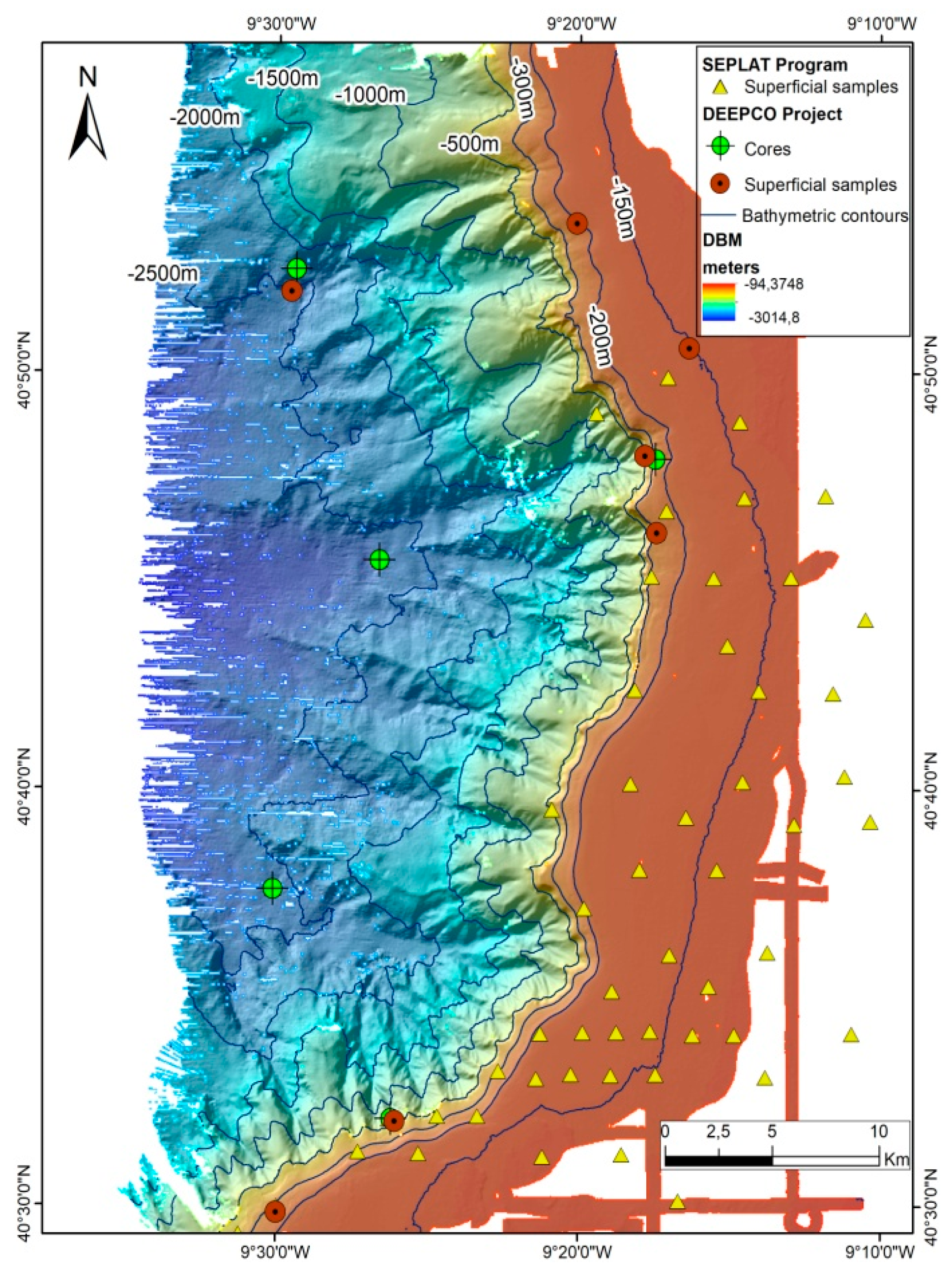
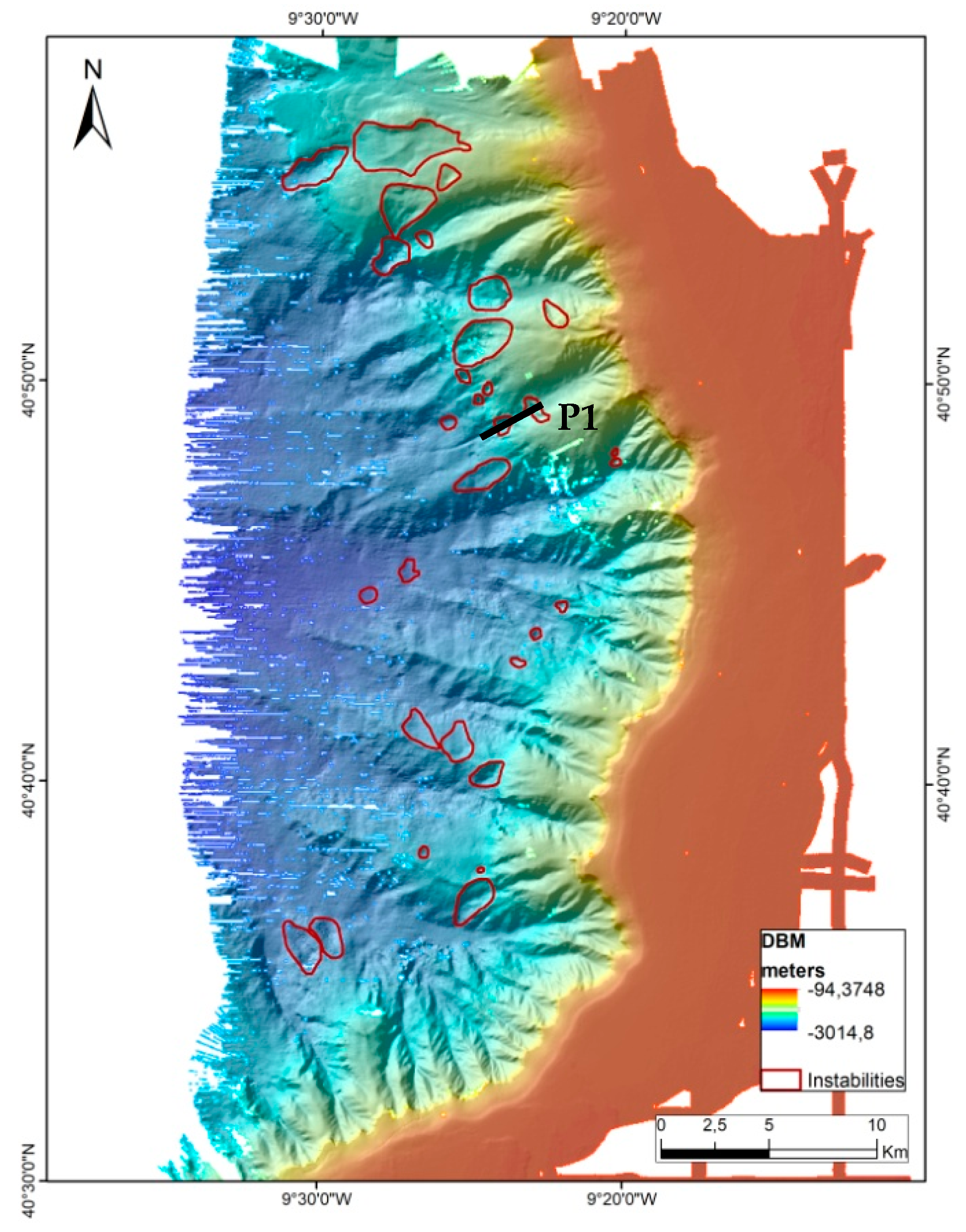
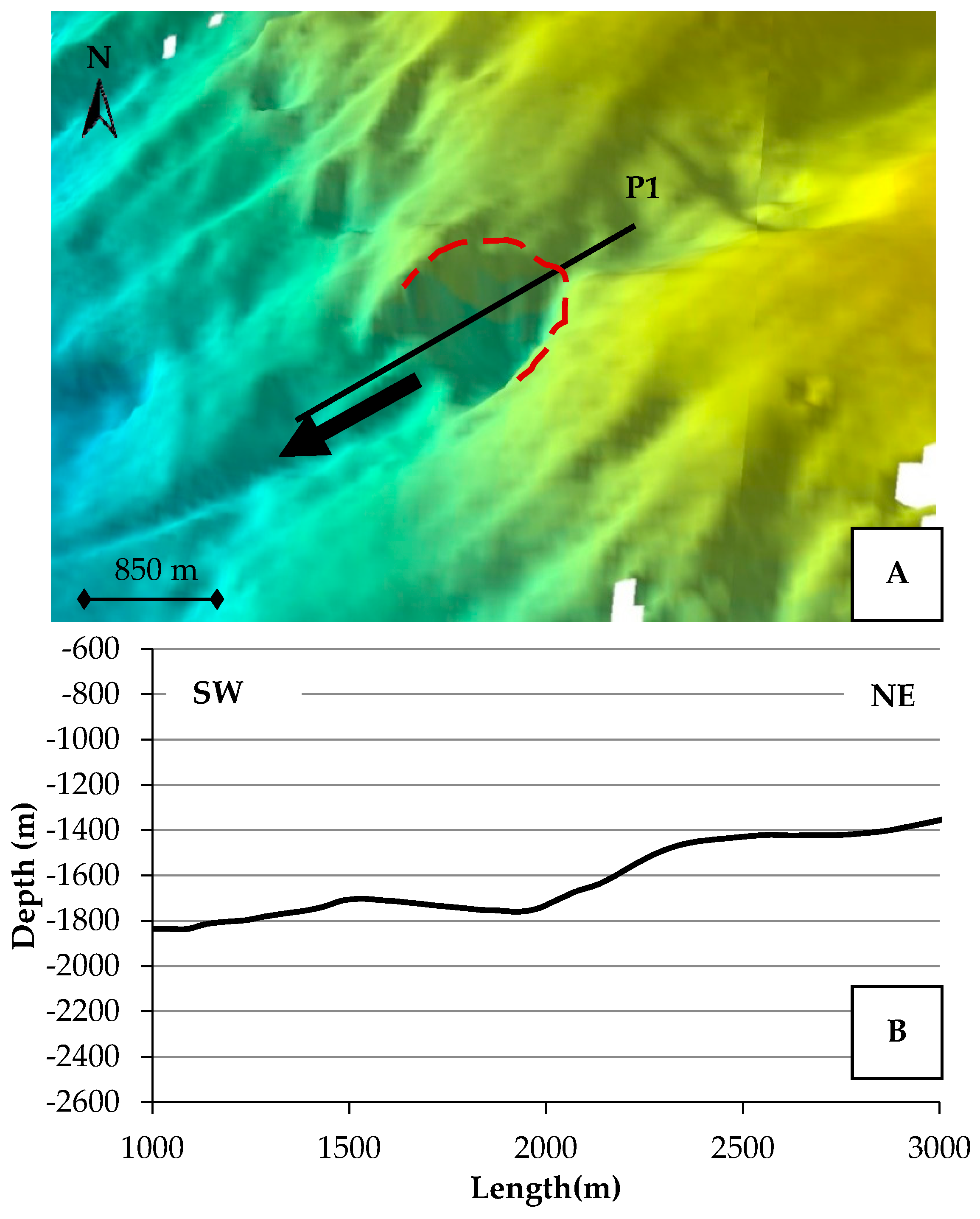
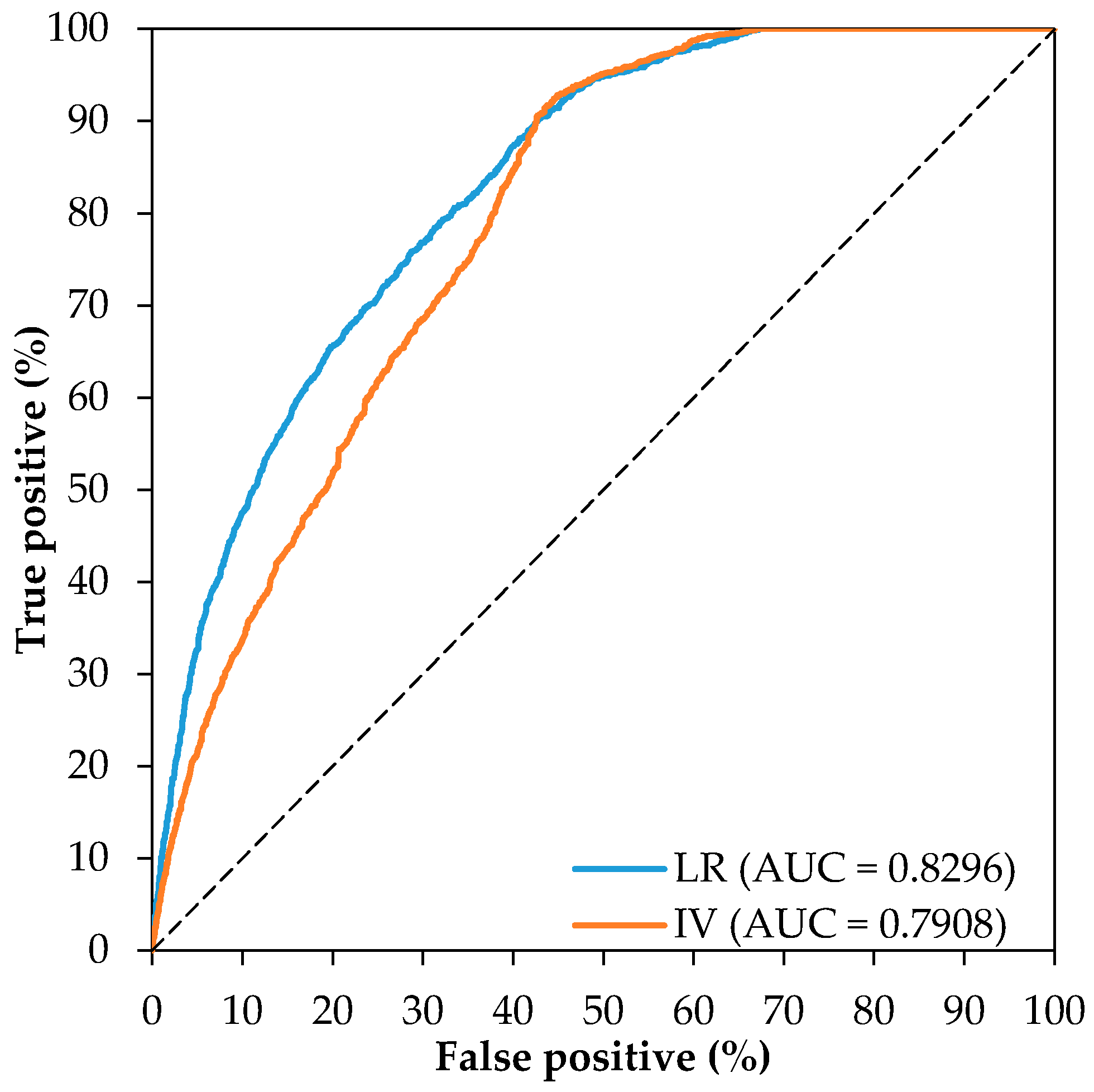
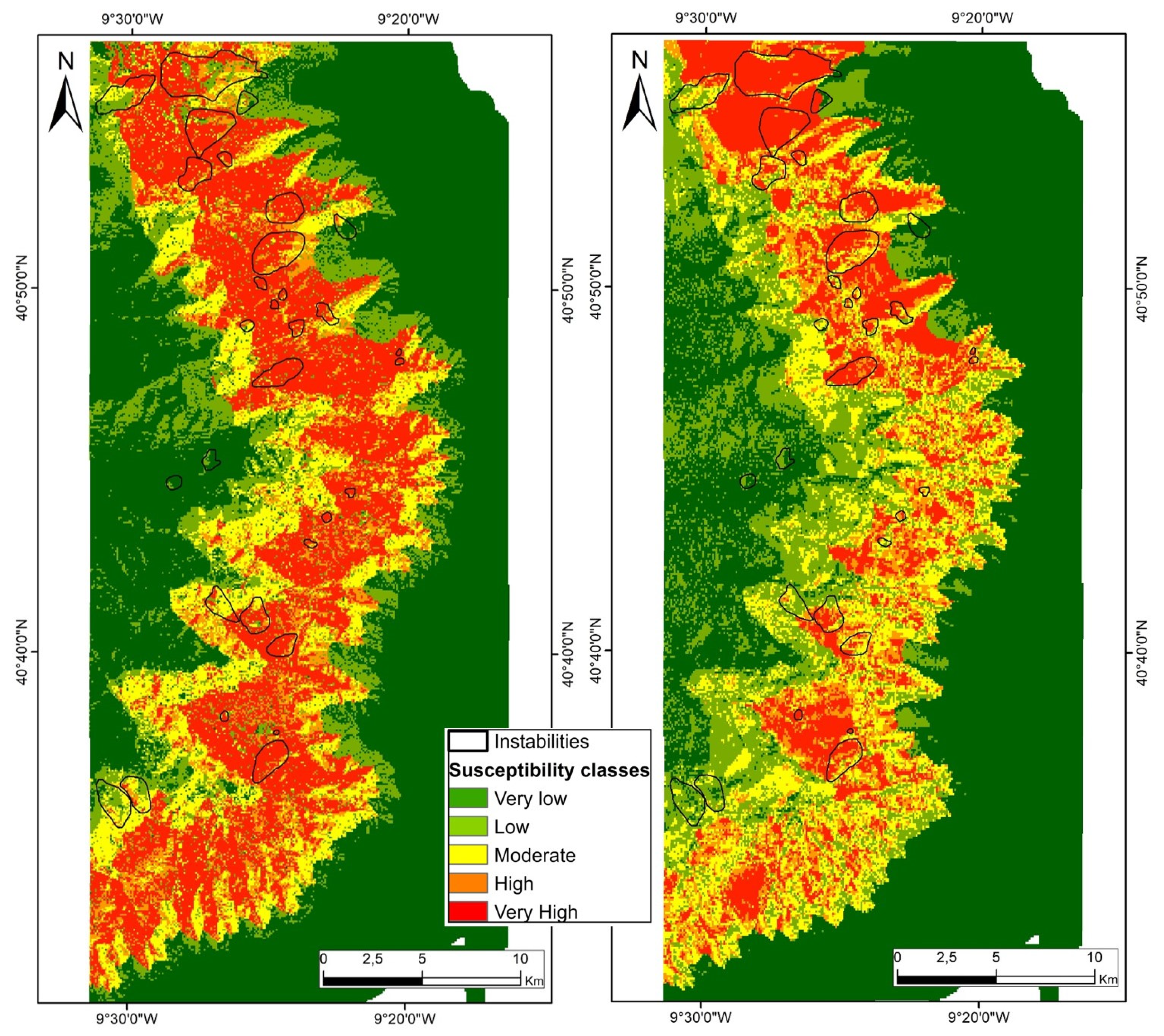
| Predisposing Factors | Classes | Reclassified Maps | |
|---|---|---|---|
| Bathymetry (m) |  | N  | 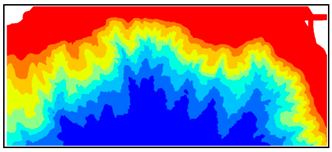 |
| Mean slope (degrees) |  | N  | 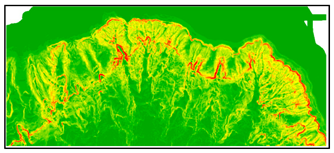 |
| Aspect (slope face exposure) |  | N  | 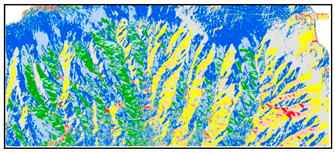 |
| Curvature |  | N  | 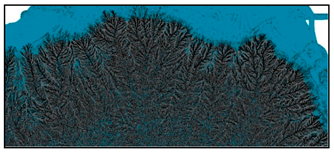 |
| Sediment cover |  | N  |  |
| Factors | Variables (Xi) | Information Value (IV) S = 17,668 Pixels; N = 405,714 Pixels. | Logistic Regression Forward Conditional (LR) ε = −22.8423 | ||
|---|---|---|---|---|---|
| Si | Ni | Ii | β | ||
| Bathymetry (m) | 2875–2400 | 1351 | 67,236 | −0.3359 | 0.0000 |
| 2400–2100 | 1802 | 43,209 | −0.0188 | 11.7773 | |
| 2100–1800 | 3535 | 36,300 | 0.3495 | 12.3096 | |
| 1800–1500 | 2943 | 30,660 | 0.3433 | 13.3058 | |
| 1500–1200 | 4055 | 30,474 | 0.4851 | 13.4463 | |
| 1200–900 | 3569 | 38,720 | 0.3256 | 13.9575 | |
| 900–600 | 413 | 32,789 | −0.5387 | 13.6531 | |
| 600–300 | 0 * | 22,924 | −2.9997 | 11.6683 | |
| 300–0 | 0 * | 103,402 | −3.6539 | 6.2134 | |
| Mean slope (degrees) | 0–5 | 1593 | 126,867 | −0.5401 | 1.1351 |
| 5–10 | 4196 | 65,889 | 0.1651 | 1.2185 | |
| 10–15 | 4440 | 67,270 | 0.1806 | 0.8517 | |
| 15–20 | 3325 | 54,280 | 0.1482 | 0.5190 | |
| 20–25 | 2042 | 42,099 | 0.0468 | 0.1781 | |
| 25–30 | 939 | 25,951 | −0.0805 | −0.2529 | |
| 30–35 | 446 | 11,472 | −0.0493 | −0.2454 | |
| 35–40 | 257 | 5250 | 0.0508 | 0.0311 | |
| 40–45 | 197 | 3078 | 0.1672 | 0.3864 | |
| 45–50 | 114 | 1704 | 0.1865 | 0.2917 | |
| 50–78 | 119 | 1854 | 0.1685 | 0.0000 | |
| Aspect (slope face exposure) | N | 821 | 18,354 | 0.0116 | 0.2859 |
| NE | 1024 | 14,686 | 0.2044 | 0.7079 | |
| E | 386 | 4361 | 0.3080 | 0.9623 | |
| SE | 779 | 8720 | 0.3121 | 0.9770 | |
| S | 2914 | 39,312 | 0.2310 | 0.7409 | |
| SW | 3745 | 76,858 | 0.0488 | 03921 | |
| W | 4253 | 114,122 | −0.0676 | 0.4504 | |
| NW | 2782 | 97,739 | −0.1847 | 0.0757 | |
| N | 964 | 31,562 | −0.1541 | 0.0000 | |
| Curvature | Concave | 8673 | 146,324 | 0.1339 | 0.1545 |
| Flat | 1361 | 112,680 | −0.5570 | 0.1189 | |
| Convex | 7634 | 146,710 | 0.0773 | 0.0000 | |
| Sediment cover | Coarse sand | 0 * | 8218 | −2.5542 | 0.2279 |
| Medium sand | 0 * | 45,612 | −3.2985 | −00449 | |
| Fine sand | 0 * | 42,355 | −3.2663 | −3.2677 | |
| Very fine sand | 0 * | 9272 | −2.6066 | −5.4053 | |
| Coarse silt | 0 * | 392 | −1.2327 | −75024 | |
| Medium silt | 6057 | 107,362 | 0.1124 | 5.8967 | |
| Fine silt | 10,803 | 125,013 | 0.2976 | 6.1883 | |
| Very fine silt | 808 | 63,718 | −0.5358 | 5.3359 | |
| Rock | 0 * | 3772 | −2.2160 | 0.0000 | |
| Factors | Ii Absolute Mean Values | Success Rate Curve AUC |
|---|---|---|
| Bathymetry | 0.8315 | 0.7930 |
| Mean slope | 0.1876 | 0.6553 |
| Aspect | 0.1888 | 0.6030 |
| Curvature | 0.4742 | 0.5838 |
| Sediment cover | 1.7697 | 0.7120 |
| Model | IV | LR |
|---|---|---|
| 5 factors: Bat.; Slope; Asp.; Sed.; Curv. | 0.7908 | 0.8296 |
| 4 factors: Bat.; Slope; Asp.; Sed.; | 0.7955 | 0.8269 |
| 3 factors: Bat.; Slope; Asp. | 0.7971 | 0.8246 |
| 3 factors: Bat.; Slope; Sed. | 0.7920 | 0.8217 |
| 2 factors: Bat.; Slope | 0.7936 | 0.8189 |
| 2 factors: Bat.; Sed. | 0.7875 | 0.7942 |
| 1 factor: Bathymetry | 0.7930 | 0.7930 |
Publisher’s Note: MDPI stays neutral with regard to jurisdictional claims in published maps and institutional affiliations. |
© 2020 by the authors. Licensee MDPI, Basel, Switzerland. This article is an open access article distributed under the terms and conditions of the Creative Commons Attribution (CC BY) license (http://creativecommons.org/licenses/by/4.0/).
Share and Cite
Lapa, N.; Marques, F.M.F.S.; Rodrigues, A. Aveiro Canyon Head (Portugal) Submarine Slope Instability Assessment. Appl. Sci. 2020, 10, 9038. https://doi.org/10.3390/app10249038
Lapa N, Marques FMFS, Rodrigues A. Aveiro Canyon Head (Portugal) Submarine Slope Instability Assessment. Applied Sciences. 2020; 10(24):9038. https://doi.org/10.3390/app10249038
Chicago/Turabian StyleLapa, Nuno, Fernando M. F. S. Marques, and Aurora Rodrigues. 2020. "Aveiro Canyon Head (Portugal) Submarine Slope Instability Assessment" Applied Sciences 10, no. 24: 9038. https://doi.org/10.3390/app10249038
APA StyleLapa, N., Marques, F. M. F. S., & Rodrigues, A. (2020). Aveiro Canyon Head (Portugal) Submarine Slope Instability Assessment. Applied Sciences, 10(24), 9038. https://doi.org/10.3390/app10249038





